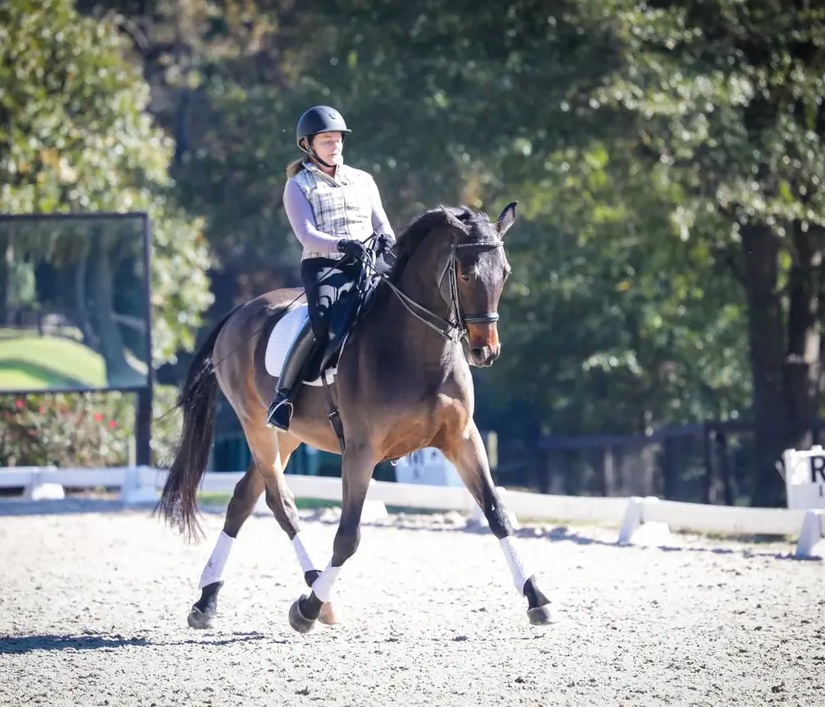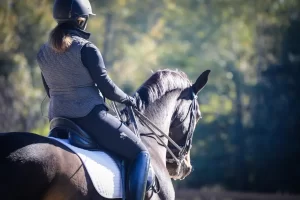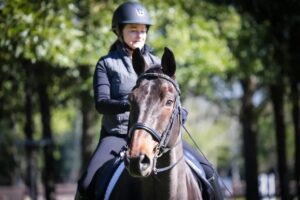In dressage, the rider’s position is crucial for achieving balance, communication, and harmony with the horse. Proper alignment, posture, and balance allow the rider to give subtle and effective aids while staying centered and stable, which in turn helps the horse move with suppleness and precision. Here’s how to develop and refine your rider position with an emphasis on dressage principles:
- Alignment of the Rider’s Body
— Ears, shoulders, hips, heels alignment: A correct dressage position requires the rider’s ear, shoulder, hip, and heel to be in a straight vertical line. This alignment helps with balance and ensures the rider’s weight is centered over the horse’s center of gravity.
— Balanced weight in the seat: Sit evenly on both seat bones (ischial tuberosities), allowing the pelvis to move in sync with the horse’s movement. Avoid leaning forward or backward, as this disrupts the horse’s balance.
— Neutral pelvis: The pelvis should be neither tilted forward nor backward. A neutral pelvis allows for proper engagement of the core and balance in the saddle. - Relaxed Upper Body
— Upright but supple posture: Maintain a tall posture without stiffness. The spine should be elongated, but the rider should stay relaxed, especially in the shoulders and arms.
— Soft elbows: Keep elbows bent and close to the body, forming a straight line from the elbow, through the forearm, to the bit. Soft, elastic elbows allow you to follow the horse’s mouth without pulling or bracing. - Seat and Core Stability
— Deep seat: A deep seat is central to dressage. Your seat should absorb the horse’s movement, rather than bouncing or gripping. Practice riding with a loose, flexible seat that follows the horse’s motion.
— Engage your core: Use your core muscles to maintain balance and posture. The strength of your core allows for independent movement of the upper body, legs, and hands without destabilizing your seat.
— Follow the movement: Your hips should follow the horse’s motion. For example, in sitting trot, allow your pelvis to move with the horse’s back while keeping your upper body still and controlled. - Leg Position
— Long leg, heels down: Your leg should hang naturally from the hip, with the knee relaxed and in contact with the saddle. The calf should lie lightly against the horse’s side, with the heel pointing downward to keep your weight grounded.
— Contact with the horse: The inside of the calf should make light, consistent contact with the horse’s barrel. This contact should be subtle, allowing for clear, precise communication when aids are given.
— Avoid gripping: Avoid gripping with your thighs or knees. This causes tension, lifts you out of the saddle, and restricts the horse’s movement. Instead, keep the leg relaxed and draped around the horse. - Hand and Rein Position
— Even contact: Hold the reins with soft, elastic hands. There should be a steady connection to the horse’s mouth, but it must remain light and responsive. Your hands should be level and positioned slightly in front of the saddle, not too high or too low.
— Independent hands: Hands should move independently of the seat. They should follow the horse’s head and neck in movements such as transitions and extensions, allowing for freedom of movement without pulling or restricting the horse.
— Straight line to the bit: Ensure there is a straight line from your elbow through the rein to the horse’s mouth. This line enables clear communication through the reins and helps the horse maintain proper contact. - Head and Neck Position
— Look where you’re going: Your head should be upright, with your chin parallel to the ground. Look ahead in the direction you want to go, as this not only helps guide the horse but also ensures you stay balanced.
— Avoid looking down: Looking down at your horse can cause you to lean forward and disrupt your balance. Keep your gaze soft and forward, anticipating the next movement or transition. - Balance and Symmetry
— Equal weight distribution: Strive for equal weight in both stirrups and seat bones. If you lean to one side, the horse will become unbalanced. Regularly check your balance by feeling the evenness in your hips and stirrups.
— Lateral balance: Be mindful of your position during lateral work (such as shoulder-in or half-pass). It’s important to maintain alignment and not shift your weight dramatically to one side, which can block the horse’s movement. - Riding Different Gaits
— Walk: At the walk, your seat should follow the four-beat rhythm of the horse, moving with each step in a controlled and gentle motion.
— Trot: For sitting trot, your seat must absorb the movement through relaxed hips and core stability. Posting trot requires fluid movement from the hips and lower back, rising softly without stiffness.
— Canter: In canter, your seat should follow the three-beat rhythm, allowing the pelvis to move with the horse’s back while keeping a quiet upper body. - Practice Without Stirrups
— Develop a deeper seat: Riding without stirrups is an excellent way to improve your seat and balance. It helps develop a more independent seat, strengthens your core, and improves your ability to stay centered in the saddle.
— Work on feel and stability: Focus on feeling the horse’s movement beneath you and maintaining stability without gripping or bracing. - Exercises to Improve Rider Position
— Lunge lessons: Ride on the lunge line without reins or stirrups to focus entirely on your position. This allows you to refine your seat, balance, and posture without worrying about controlling the horse.
— Shoulder and hip mobility exercises: Off the horse, work on flexibility exercises for your hips and shoulders to ensure you can maintain a relaxed, supple position while riding.
— Core strengthening exercises: Pilates, yoga, and other core-focused workouts are great for building the core stability required for maintaining a strong dressage position. - Get Feedback
— Mirror work: If possible, ride in an arena with mirrors to visually check your position during various movements.
— Video analysis: Have someone record your rides so you can review and spot areas for improvement in your posture and alignment.
A correct and effective rider position in dressage forms the foundation for clear communication with your horse. Developing a deep seat, a relaxed yet upright posture, independent hands and legs, and maintaining balance and symmetry are essential components. Regular practice, self-awareness, and feedback from a trainer will help you refine your position over time. Mastering your position allows the horse to move more freely and express its full potential in dressage movements.




